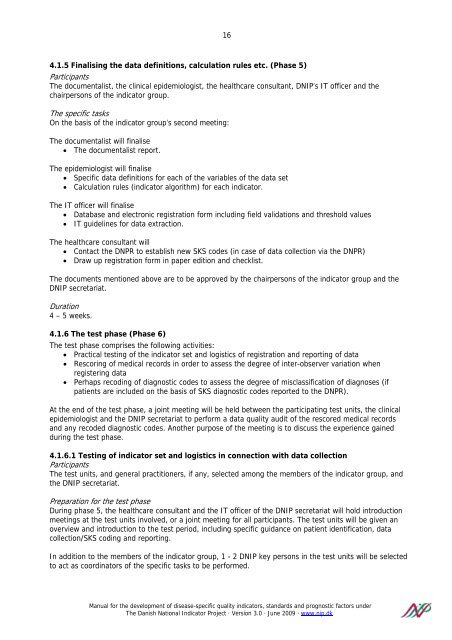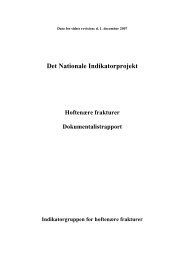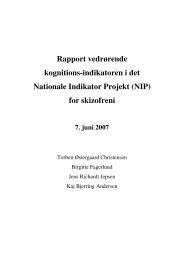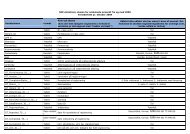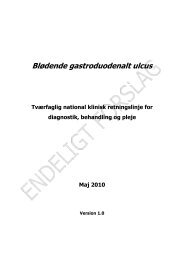The Danish National Indicator Project - NIP
The Danish National Indicator Project - NIP
The Danish National Indicator Project - NIP
Create successful ePaper yourself
Turn your PDF publications into a flip-book with our unique Google optimized e-Paper software.
4.1.5 Finalising the data definitions, calculation rules etc. (Phase 5)<br />
Participants<br />
<strong>The</strong> documentalist, the clinical epidemiologist, the healthcare consultant, D<strong>NIP</strong>’s IT officer and the<br />
chairpersons of the indicator group.<br />
16<br />
<strong>The</strong> specific tasks<br />
On the basis of the indicator group’s second meeting:<br />
<strong>The</strong> documentalist will finalise<br />
• <strong>The</strong> documentalist report.<br />
<strong>The</strong> epidemiologist will finalise<br />
• Specific data definitions for each of the variables of the data set<br />
• Calculation rules (indicator algorithm) for each indicator.<br />
<strong>The</strong> IT officer will finalise<br />
• Database and electronic registration form including field validations and threshold values<br />
• IT guidelines for data extraction.<br />
<strong>The</strong> healthcare consultant will<br />
• Contact the DNPR to establish new SKS codes (in case of data collection via the DNPR)<br />
• Draw up registration form in paper edition and checklist.<br />
<strong>The</strong> documents mentioned above are to be approved by the chairpersons of the indicator group and the<br />
D<strong>NIP</strong> secretariat.<br />
Duration<br />
4 – 5 weeks.<br />
4.1.6 <strong>The</strong> test phase (Phase 6)<br />
<strong>The</strong> test phase comprises the following activities:<br />
• Practical testing of the indicator set and logistics of registration and reporting of data<br />
• Rescoring of medical records in order to assess the degree of inter-observer variation when<br />
registering data<br />
• Perhaps recoding of diagnostic codes to assess the degree of misclassification of diagnoses (if<br />
patients are included on the basis of SKS diagnostic codes reported to the DNPR).<br />
At the end of the test phase, a joint meeting will be held between the participating test units, the clinical<br />
epidemiologist and the D<strong>NIP</strong> secretariat to perform a data quality audit of the rescored medical records<br />
and any recoded diagnostic codes. Another purpose of the meeting is to discuss the experience gained<br />
during the test phase.<br />
4.1.6.1 Testing of indicator set and logistics in connection with data collection<br />
Participants<br />
<strong>The</strong> test units, and general practitioners, if any, selected among the members of the indicator group, and<br />
the D<strong>NIP</strong> secretariat.<br />
Preparation for the test phase<br />
During phase 5, the healthcare consultant and the IT officer of the D<strong>NIP</strong> secretariat will hold introduction<br />
meetings at the test units involved, or a joint meeting for all participants. <strong>The</strong> test units will be given an<br />
overview and introduction to the test period, including specific guidance on patient identification, data<br />
collection/SKS coding and reporting.<br />
In addition to the members of the indicator group, 1 - 2 D<strong>NIP</strong> key persons in the test units will be selected<br />
to act as coordinators of the specific tasks to be performed.<br />
Manual for the development of disease-specific quality indicators, standards and prognostic factors under<br />
<strong>The</strong> <strong>Danish</strong> <strong>National</strong> <strong>Indicator</strong> <strong>Project</strong> · Version 3.0 · June 2009 · www.nip.dk


